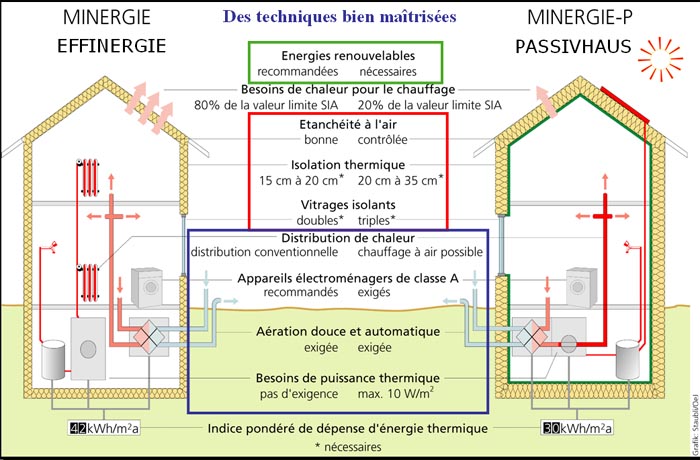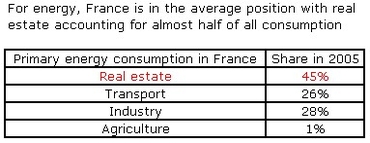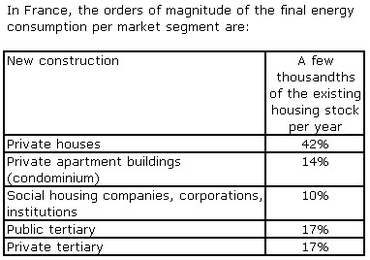Climate change, energy and real estate: the new deal
The former Minister of Ecology Corinne Lepage, and the architect Philippe Madec, were also invited to give their points of view, and presented a situation in which climate change and policies are all pointing in the same direction, towards an inevitable change in the way of building and in how we occupy land. Although there is no doubt that professional practices will change profoundly, how will they provide a solution considering the extent of this problem, and how long will it take?
GIEC1 reports state that the quantity of greenhouse effect gases must not exceed 450 parts per million by 2050, to prevent the temperature increase from exceeding 2°C. But considering growth in tropical countries, this objective already seems difficult to achieve. The damage to services offered by nature is already estimated as thousands of billions of dollars per year2. If no ambitious policy is adopted, the annual drop in gross worldwide product per inhabitant will be more than 10% by the end of the century, if we include ecological losses and human lives. In simple economic terms, the cost of inaction is greater than the cost of action. And real estate is the cause of almost half of the problem, accounting for between 40 to 50% of energy consumption depending on the country. Associated with transport and town planning more generally, it is undoubtedly the main concern of two major planet-wide challenges that we have to face, namely climate change and energy supply.
A new paradigm
But above all, an energy efficient building is a new overall concept including architecture and the building envelope, climate and equipment. As emphasized by Philippe Madec in talking about transport and widely scattered living areas, "sustainable development will only be possible if we accept that the different participants and businesses are dependent on each other. Wanting to keep existing construction, renovation and building management processes while introducing energy and environmental considerations would generate high investment costs for low energy efficiency."
"It is a genuinely new philosophy for construction players, says Jean Carassus, head of the International Building and Energy Comparison Project in the PREBAT program3 and Director of the CSTB Economy and Human Sciences Department. "It is a new reference system requiring new skills. It inherently requires new financing methods, cooperation between architects, engineers and economists, and involvement of the future operator in the design and successive optimisations, construction taking special care with air tightness, and demanding operation-maintenance."
But it also offers an opportunity for building players and managers to enrich training, practices, and their image. Returns on investments are also obviously possible if skills are well controlled. Professionals in real estate now overestimate the additional initial investment for a high environmental quality building, which is around 5%, thus taking the risk of producing buildings that are obsolete as soon as they are built. For example in the United States, the difference in the initial investment between a LEED green building and other buildings is of the order of 3%, while in Switzerland the MINERGIE label is not granted if the additional investment is more than 10%.
- GIEC: Groupe Intergouvernemental sur l’Evolution du Climat (Inter-governmental Group on Climate Change).
- The current rate at which resources are being used and at which species are disappearing is such that services rendered by ecosystems (pollination by bees, etc.) are regressing and have a non-negligible economic cost.
- PREBAT: Programme de Recherche et d’Expérimentation sur l’Energie dans le Bâtiment (Research and Experimental Program on Energy in Buildings), co-financed by ADEME, PUCA and CSTB (http://www.prebat.net).
- Energy Efficiency in Buildings Data from the World Business Council for Sustainable Development project (http://www.wbcsd.org).
The different high energy and environmental efficiency construction models
Simplifying matters, PREBAT identified three international models for control over energy in buildings.
- The 1st is based on the principle of low consumption in over-insulated buildings (including the German passive house (PASSIVHAUS), the Swiss MINERGIE label, and the French EFFINERGIE label).
- The 2nd model combines the energy efficiency objective with other environmental targets (for example the American LEED, the British BREEAM and the French HQE labels).
- The 3rd model combines energy savings and energy production (these are American wood houses and Japanese prefabricated houses using energy production by photovoltaic cells, thermal solar or heat pump). This model opens up the way towards positive energy buildings.
The three models can be used in France. In the future, HQE type certifications could strengthen their energy concerns, but a hybrid model could also be developed, combining the HQE and Effinergie labels for the same building.



